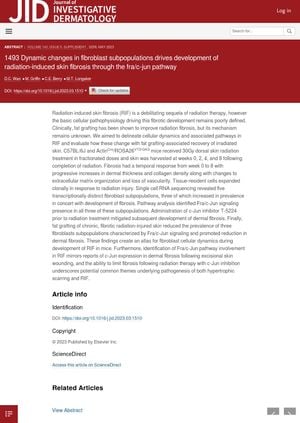Dynamic Changes in Fibroblast Subpopulations Drive Development of Radiation-Induced Skin Fibrosis Through the Fra/c-Jun Pathway
April 2023
in “
Journal of Investigative Dermatology
”

TLDR Radiation treatment causes skin fibrosis by increasing certain fibroblast subpopulations, but using a c-Jun inhibitor or fat grafting can reduce this effect.
Radiation-induced skin fibrosis (RIF) is a harmful side effect of radiation therapy, and its cellular causes are not well understood. This study aimed to understand the cellular changes and pathways involved in RIF and how fat grafting can help recover irradiated skin. The study found that fibrosis increased over time from week 0 to 8 after radiation treatment, with increases in dermal thickness, collagen density, changes to the extracellular matrix, and loss of vascularity. Single cell RNA sequencing revealed five distinct fibroblast subpopulations, three of which increased in prevalence with the development of fibrosis. These three subpopulations were found to have Fra/c-Jun signaling. The use of a c-Jun inhibitor before radiation treatment reduced the development of dermal fibrosis. Fat grafting of chronic, fibrotic radiation-injured skin reduced the prevalence of the three fibroblast subpopulations with Fra/c-Jun signaling and promoted a reduction in dermal fibrosis. This study provides a map of fibroblast cellular changes during the development of RIF in mice and identifies the involvement of the Fra/c-Jun pathway in RIF.

